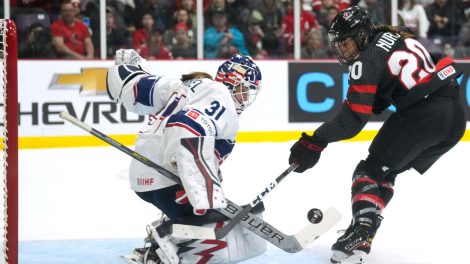About five months ago, the hockey world was looking forward to gathering in Montreal and welcoming in a new class of prospects at the 2020 NHL Draft where Quebec-born Alexis Lafreniere would be hearing his name called first overall so close to home.
Now, he and the rest of this year’s prospects will hear their names called at home, while continuing to practise proper safety protocols during the COVID-19 pandemic.
Tuesday’s 2020 NHL Draft will no doubt look a lot different this year, with the NHL conducting a virtual draft — similar to those we’ve seen already in the WNBA and NFL, who went ahead with theirs as scheduled back in the spring.
The WNBA was the first North American professional league to take on the challenge of a virtual draft, on April 17, and their resounding success showed us it was not only possible to pull off, but also really entertaining while still giving the athletes a memorable experience as they took this next step in their career. A week later, the NFL conducted its three-day, 255-pick draft, giving football fans a welcomed distraction with another successful (and glitch-free!) production. The National Women’s Hockey League also went ahead with its draft in April, which wasn’t broadcast but was able to bring hockey into the homes of many sports fans in a unique way on social media.
[snippet id=4982512]
All three drafts were resounding successes, bringing new ideas and elements to the table and providing valuable lessons for other leagues to learn from them.
By now, we’re pretty used to seeing sports and television productions produced remotely, and getting a webcam view into the home offices and basements of those on-air is just part of our new normal. The NHL pulled off its quarantined return-to-play without a hitch, we’re a few games away from crowning champs in the WNBA and NBA’s respective bubbles, and we’re more than used to seeing empty ballparks and football stadiums as the sports world has resumed.
Still, this year’s NHL Draft will take a little getting used to.
NHL commissioner Gary Bettman will still be hosting Round 1, but he’ll do so from the NHL Network’s New Jersey studio (the same setting we saw during the draft lottery back in August). Deputy Commissioner Bill Daly will host Rounds 2-7 from the same studio, and teams will continue the tradition of announcing their own picks — just not from a formal draft stage, but rather their own remote location.
Not seeing the league’s latest first-round picks make the trip from their seats to the draft stage, hearing the reactions of the crowd, and seeing players interviewed in person as their futures are beginning to unfold… that will be an adjustment. But it’s still a joyous occasion, and will offer hockey fans another glimpse of normalcy at a time when we’d usually be digging into a fresh season of NHL hockey.
[relatedlinks]
Here’s a refresher of how the WNBA, NFL, and NWHL conducted their virtual drafts, and how those experiences might shape our expectations of what’s to come in the NHL on Tuesday night.
Approach with compassion
This one’s listed first, because it’s the most important lesson learned from throughout this entire experience — both in sports and society as a whole. This draft isn’t going to be what we’re used to seeing, and it isn’t going to be perfect — and that’s okay. Everyone’s doing the best they can, while still following government and league guidelines to keep everyone safe and in good health. There might be lags during video interviews, awkward transitions, and a few technical glitches. But if we all approach this event knowing the stakes as well as the stresses, we’ll get through it and be able to welcome and celebrate a new class of NHL hopefuls.
Conduct a mock draft (or two)
One of the bigger storylines going into the NFL draft was around how such a large-scale draft would actually work – and what would happen if, well, it didn’t.
To address concerns and troubleshoot any potential issues, the NFL conducted a two-round mock draft among all 30 teams on the Monday of draft week. Reported complaints of glitches, bandwidth issues, and unmuted phones making for a mess of a conference call allowed the NFL to resolve these issues before the real deal and give GMs more confidence going into the event.
Even in isolation, it’s going to need to be a team effort all-around. WNBA commissioner Cathy Engelbert talked about enlisting the help of her daughter and son while she announced each pick from her living room. The NFL allowed one I.T. professional at the home of every team’s designated drafter to step in if any technical difficulties occurred, and several NHL general managers have talked about their own comfort levels with the technology.
In the days and weeks after the draft, a number of NFL teams released behind-the-scenes videos of how their draft setups came together. It was interesting to see how much communication was required at all levels, and how teams set themselves up for maximum success on draft night.
Now several months later, it’s likely we’ll see fewer home office setups and more socially-distanced boardrooms as regulations allow.
Several NHL general managers have spoken about doing test runs of their own, and getting comfortable with the tech setup and how communications will be conducted among staff.
Red Wings GM Steve Yzerman said he’ll be in a socially-distanced conference room at the team’s facility: “This morning, we did our own bit of testing, walking through the technology we’ll be using … The league is running through it with our IT people to make sure we’re running it how they want it to run, and making sure it’s operational. I’m very comfortable that it should work out really well.
“We’ve got a nice spaced-out conference room, and it will be a little quieter in there,” Yzerman continued, via NHL.com. “It will be a little less hectic. Particularly in Round 1 when the building is full, the fans are chanting and there is a lot of buzz in the building. With a lot of people around, it can be very distracting. I kind of like this [virtual] format. You do not have the ability to quickly catch the eye of a general manager, but we’ve got multiple phone lines. You can get a lot done quickly.”
Draft Table: Set. pic.twitter.com/TznBIHCWeO
— New York Rangers (@NYRangers) October 2, 2020
“We’ve gone through multiple scenarios, we’ve had multiple mock drafts,” Senators general manager Pierre Dorion, owner of the third and fifth overall picks, told reporters. “We’ll be ready.”
San Jose Sharks GM Doug Wilson said he spoke with management from other leagues to get advice.
“We’ve talked with other GMs from other sports that have had to go through this,” Wilson told reporters, via The Associated Press. “We’ll have enough setup that we’ll have all of our staff accessible.”
Let fans behind the scenes
One of the best parts of watching the draft is the drama of it all — even (or maybe especially) before the first team is officially on the clock. With every team’s front office sitting at tables on the draft floor, it’s the only time so many hockey movers and shakers are in one place and looking to make deals. Watching GMs mill about, mingle, seeing who’s on the phone(s), seeing traditional foes chatting (or not talking at all)… it makes for great T.V. And even if a trade doesn’t go down, it’s the possibility of what’s being discussed in plain view that makes this event so much fun to watch.
A virtual draft means much of that intrigue is missing — though, it doesn’t have to be completely gone. The NFL had a camera trained on each team’s GM and head coach, stationed in their respective home offices, which still allowed fans a glimpse behind the scenes. (It also ensured they were following proper social distancing protocols.) Because NFL teams’ staff typically conduct their drafts from their respective “war rooms” at the clubs’ facilities, seeing NFL GMs and coaches working separately in their own homes wasn’t as big an adjustment as it would be for those in the NHL.
The NHL will also implement cameras fixed on all teams’ GMs to let fans in on any action.
Maybe we’ll see some more sweet home setups…
Put prospects first
The draft has changed in presentation over the years but prospects are, of course, always front and centre. In fact, now more than ever, it will be really important for the NHL to give the class of 2020 a positive, memorable experience despite the fact that they won’t be hitting the draft stage for that moment they’ve no doubt envisioned over the years as they’ve strived to make it to the pros.
This is where the WNBA really shone. Commissioner Cathy Engelbert made it a priority to keep players front and centre, knowing this group of prospects wouldn’t get to enjoy the kind of in-person experience and celebration as those drafted before them.
Both the WNBA and NFL drafts saw many draftees let fans into their home virtually via a league-provided camera, and both also sent out draft packages featuring league gear and team hats to give draftees that traditional draft-day token. The NHL plans to do the same, providing top prospects with multiple teams’ gear and setting them up for virtual interviews so their new fanbases can hear from them first-hand from home.
Both the NFL and WNBA struggled at times to capture that live “draft moment” — not surprising, when you’re dealing with delays and a number of different feeds — but being able to see draftees waiting and then celebrating with their families was a valuable part of the experience, just like it is during the draft in normal, in-person situations.
Don’t force fan interaction
In an effort to re-create the fan experience, and the time-honoured tradition of booing the commissioner, the NFL brought in a backdrop of each teams’ fans via webcam feeds to serve as a backdrop as Roger Goodell read out each selection. It was an admirable idea, and likely a difficult feature to coordinate in an effort to bring in some semblance of normalcy, but it mostly missed the mark and didn’t appear to be worth the effort. It also pushed Goodell into forced interactions, which wasn’t a great look overall.
The NWHL, which presented its draft solely online, brought the hockey community together by going to where the fans already are: Hockey Twitter. The league reached out to various people in and around the hockey and sports community to announce picks with a personalized video and graphic for each prospect being chosen. In doing so, they were able to virtually bring together athletes from various leagues and communities, including the NHL and WNBA, as well as media personalities and other supporters, making for a total team effort online that captured fans’ attention and most likely brought in new supporters, too.
Here’s a special presentation for the 10th Overall Pick of the 2020 #NWHLDraft for the @Riveters @NorthWellHealth pic.twitter.com/YKNYiDX0el
— NWHL (@NWHL) April 29, 2020
Here’s @Steve_Dangle to announce the 14th Overall Pick of the 2020 #NWHLDraft for the @BuffaloBeauts pic.twitter.com/1nBamNPCjn
— NWHL (@NWHL) April 29, 2020
Here’s @NatAchon of the @IndianaFever to announce the 15th Overall Pick for @TorontoNWHL @WNBA // @TheWNBPA pic.twitter.com/dpkUjJCR4l
— NWHL (@NWHL) April 29, 2020
Bring your dog
OK, this is a really just a message for all the coaches, GMs, insiders, and prospects out there who plan to operate from home, in hopes of making some more internet magic like this gem from Bill Belichick and his pup, Nike:
Bill Belichick trying out a new draft strategy.
(: @SBNation) pic.twitter.com/vw846QCYXK
— Sportsnet (@Sportsnet) April 24, 2020
Worth a shot, right?
[relatedlinks]









